Macros and MIDI Control
Massive X lets you control how to interact with your sound through MIDI controls for Pitch Bend, Mod Wheel, and Aftertouch as well as 16 Macro controls.
The Header includes a number of control sources that you can use to interact with your sound. Assign the modulation wheel, pitch bend and aftertouch to parameters for instant playability from a keyboard controller, or use Macros for automation and MIDI control in your host.
The following control sources are available:

PB (Pitch Bend): A standard MIDI control found on any keyboard controller, often in the form of a spring-loaded wheel.
M (Modulation): A standard MIDI control found on most keyboard controllers, often in the form of a freely adjustable wheel.
AT (Aftertouch): A special MIDI expression found on many keyboard controllers, transmitting the amount of pressure applied to a pressed key.
1-16 (Macros): Global controls that can be used for automation and MIDI control in your host.
Single and Multiple Parameters
All control sources available in the Header can either take over the full range of a single parameter or control any number of parameters to a varying degree:
Single parameter assignment, refer to Assigning Macros to Single Parameters.
Multiple parameter assignments, refer to Assigning Macros to Multiple Parameters.
Macro Assignments
You can conveniently manage existing assignments by removing, muting, and replacing them. Macros can also be renamed, which is especially useful when assigning them to multiple parameters.
Removing and muting Macros, refer to Removing and Muting Macros.
Replacing Macros, refer to Replacing Macros.
Assigning Macros to Single Parameters
The controls in the Header can take over the full range of a single parameter, which is called a 1:1 mapping. For example, you can use the modulation wheel to control the Wavetable Position.
To assign the modulation wheel to control the Wavetable Position:
Drag and drop the modulation wheel icon (M) from the Header onto the Wavetable Position knob.
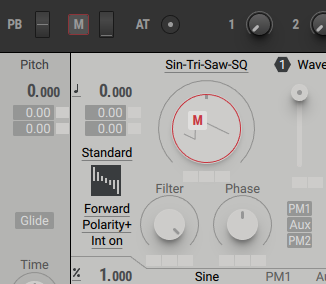
The Wavetable Position is now controlled by moving the modulation wheel on your keyboard controller.
Tip
For information about removing or muting Macro assignments, refer to Removing and Muting Macros.
Assigning Macros to Multiple Parameters
The controls in the Header can adjust multiple parameters at the same time, and to a varying degree.
For example, you can use Macro 1 to control both the Wavetable Position and the Wavetable's Filter control:
Drag and drop the Macro icon (1) from the Header onto the first modulation slot of the Wavetable Position.
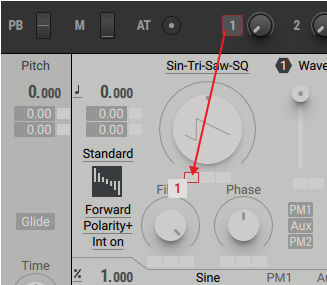
Click and drag the first modulation slot of the Wavetable Position to adjust the modulation amount.
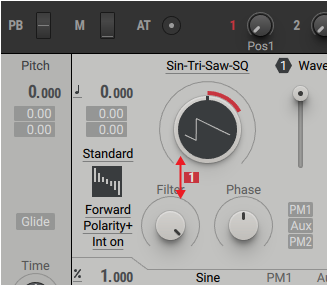
Drag and drop the Macro icon (1) from the Header onto the first modulation slot of the Wavetable's Filter control.
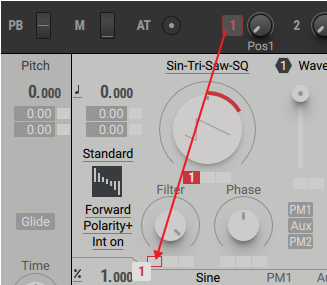
Click and drag the first modulation slot of the Wavetable's Filter control to adjust the modulation amount.
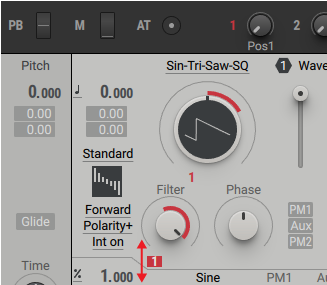
By playing a note and turning Macro 1 you can now control the two parameters on the Wavetable oscillator at the same time.
Tip
For information about removing or muting Macro assignments, refer to Removing and Muting Macros.
Replacing Macros
In some scenarios, you might want to remove a 1:1 Macro assignment and instead assign the Macro to a modulation slot of the same parameter, or vice versa.
To replace a 1:1 Macro assignment for a parameter with a modulation slot assignment:
Drag and drop the Macro icon from the Header onto the modulation slot.
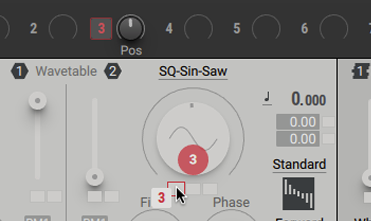
A dialog box appears, asking you to confirm the change. Click OK to remove the 1:1 Macro assignment, and replace it with a modulation slot assignment.
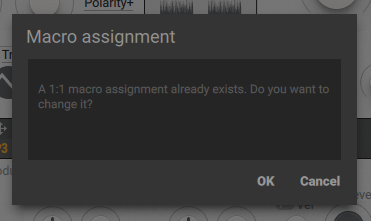
To replace a modulation slot assignment for a parameter with with a 1:1 Macro assignment:
Drag and drop the Macro icon from the Header onto the parameter's control.
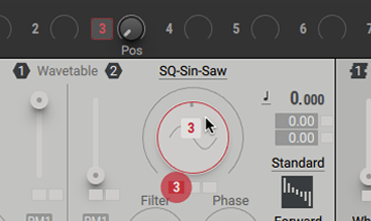
A dialog box appears, asking you to confirm the change. Click OK to remove the Macro's modulation slot assignment, and replace it with a 1:1 Macro assignment.
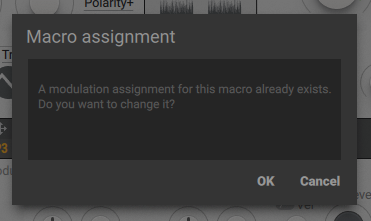
Removing and Muting Macros
You can remove or mute Macro assignments using the context menu for each Macro by right-clicking on the Macro number. When a Macros is assigned to one control, it is referred to as 1:1 mapping.
Single Assignment
To remove a Macro assignment from a single control:
Right-click the Macro number, located to the left of the corresponding control knob.
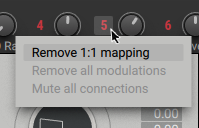
Select Remove 1:1 mapping.
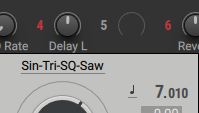
The assignment is now removed and the Macro control is blank.
Multiple Assignment
When a Macro is assigned to multiple parameters, you can remove all assignments at once. To remove all modulations from a Macro control:
Right-click the Macro number, located to the left of the corresponding control knob.
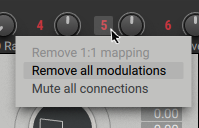
Select Remove all modulations.

The assignments are now removed and the Macro control is blank
You can mute Macro controls without removing the assignments. This is particularly useful if you want to bypass the modulation assignments for a particular Macro. This provides a quick AB reference for your modulation assignments.
To mute a Macro, follow the steps above, but select Mute all connections.
The assignments are now muted.
Renaming Macros
The Macro controls are automatically named when they are assigned to a parameter. In some instances, for example, when multiple parameters are assigned to the same Macro, you may want to rename the Macro to represent the full functionality of the control.
To rename a Macro control:
Double-click the Macro name, located under the corresponding control knob, to highlight it.

Type the new Macro name in the text field.
